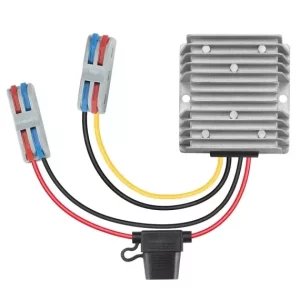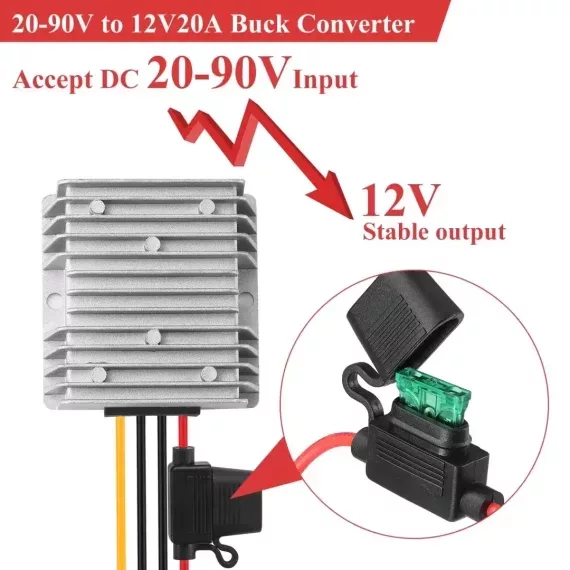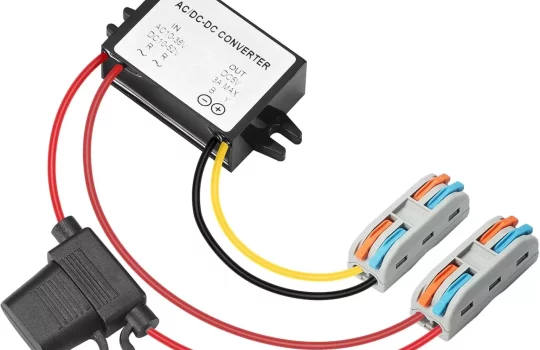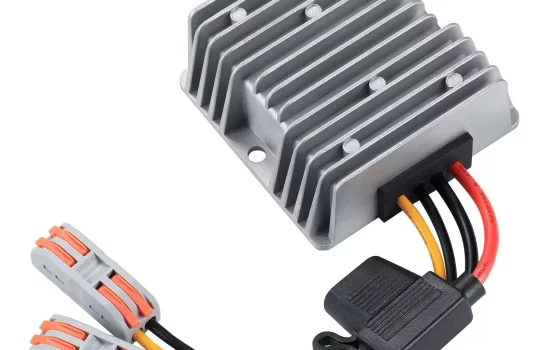Golf carts have evolved from simple vehicles used on golf courses to versatile personal transportation solutions for communities, resorts, industrial sites, and even farms. As their usage expands, so does the need for additional electrical accessories such as headlights, tail lights, sound systems, GPS devices, and charging ports. However, there is one major challenge—most modern golf carts run on 48V battery systems, while most accessories require only 12V to operate.
This is where a 48V to 12V voltage reducer becomes an essential component. It ensures that your golf cart can safely power low-voltage accessories without damaging them. But how does a voltage reducer work? Why is it necessary? And how do you choose the right one for your golf cart?
This article will provide a deep dive into the function, importance, selection, and installation of 48V to 12V voltage reducers, helping you understand why they are crucial for your golf cart’s performance and longevity.
1. What is a Voltage Reducer?
A voltage reducer is an electrical device that steps down a higher voltage (48V in this case) to a lower, more manageable voltage (12V). Golf carts primarily use deep-cycle lead-acid or lithium-ion batteries to power their motors. These batteries supply 48V, which is excellent for propulsion but too high for auxiliary accessories that are designed to run on 12V systems.
By installing a voltage reducer, the electrical system can provide stable 12V power to accessories like:
- LED or halogen lights (headlights, brake lights, turn signals)
- Radios and speakers
- GPS and navigation systems
- Charging ports for phones and small devices
- Electric cooling fans
Without a voltage reducer, running accessories directly from the 48V battery pack would burn out the components due to excessive voltage. Alternatively, tapping into just one of the 12V batteries in a multi-battery system would cause uneven wear and premature battery failure.

2. Why Do You Need a 48V to 12V Voltage Reducer?
Many golf cart owners underestimate the importance of a proper voltage reduction system until they start experiencing electrical failures. Here are the key reasons why a voltage reducer is a necessity rather than an option:
A. Prevents Electrical Damage
Golf cart accessories are designed for 12V operation. Without a reducer, direct connection to a 48V system would instantly overload and destroy sensitive electronics. Even if the device does not fail immediately, prolonged exposure to higher voltage causes overheating and internal component degradation.
B. Ensures Even Battery Wear
Some people mistakenly try to power 12V devices by connecting them directly to one or two 12V batteries in their 48V series battery pack. This creates uneven battery drain, leading to:
- Imbalanced battery wear, shortening overall battery lifespan
- Frequent battery replacements due to premature failures
- Performance issues, as some batteries deplete faster than others
A voltage reducer pulls power evenly from the entire 48V pack, ensuring balanced discharge and longer battery life.
C. Improves Golf Cart Reliability
A stable 12V output means accessories function properly without voltage fluctuations. Unstable power supply can lead to:
- Dim headlights or flickering LED lights
- Poor audio quality from radios and speakers
- Inconsistent GPS or navigation errors
With a quality voltage reducer, you eliminate power inconsistencies and improve the reliability of all accessories.
D. Reduces Heat and Energy Loss
High voltage reduces efficiency in low-voltage components. Without proper voltage reduction, accessories work harder, generating excess heat and wasting energy. A high-efficiency DC-DC voltage reducer minimizes heat loss, ensuring optimal energy use and longer-lasting components.

3. How to Choose the Right Voltage Reducer for Your Golf Cart
Not all 48V to 12V reducers are the same. Choosing the wrong one can lead to power inefficiency, overheating, and even system failure. Here are key factors to consider when selecting the right reducer for your golf cart:
A. Power Rating (Amperage and Wattage)
The power output of a voltage reducer is measured in amperes (A) or watts (W). Your choice should be based on the total electrical demand of your golf cart’s accessories.
Here’s a rough guide to common accessory power usage:
- LED headlights & taillights → 3-5A
- Halogen headlights → 7-10A
- Radio & speakers → 2-5A
- GPS system → 1-2A
- USB charging ports → 2-3A
To calculate the total wattage required, use the formula:
Power (W) = Voltage (V) × Current (A)
For example, if your total accessory load is 15A at 12V, you need a reducer with at least:
2V × 15A = 180W
It’s best to choose a reducer with higher capacity than your estimated needs to avoid overloading.
B. Efficiency Rating
High-quality voltage reducers have efficiency ratings above 85%, meaning they waste less power as heat. Poorly designed reducers can waste energy, reducing your golf cart’s battery life.
C. Build Quality & Heat Dissipation
A good DC-DC converter should have:
- Aluminum casing for better heat dissipation
- Waterproof and dustproof design (IP67 rating recommended)
- Overheat and overload protection
D. Installation and Compatibility
Ensure the reducer is compatible with your golf cart model. Some require simple plug-and-play connections, while others need manual wiring.
Look for:
- Inline fuse protection for safety
- Clear installation instructions
- Pre-wired connectors to simplify setup
4. Installation and Maintenance Tips
A. Installing the Voltage Reducer
- Turn off the golf cart and disconnect the battery.
- Mount the voltage reducer in a well-ventilated area, preferably near the battery pack.
- Connect input wires (48V positive and negative) to the golf cart battery terminals.
- Connect output wires (12V positive and negative) to the accessory distribution block.
- Secure all connections with heat shrink tubing or electrical tape.
- Test the system before finalizing installation.
b. Regular Maintenance
- Inspect connections periodically for loose or corroded wires.
- Check for overheating during prolonged use.
- Clean dust and debris from the voltage reducer casing.
Proper maintenance ensures your voltage reducer lasts for years without performance degradation.
A 48V to 12V voltage reducer is an essential component for any golf cart that powers additional accessories. It ensures that electrical devices run efficiently, prevents uneven battery drain, and improves the overall performance of your cart’s electrical system.
By choosing the right voltage reducer with adequate power capacity, high efficiency, and durable construction, you can safely integrate lights, sound systems, GPS units, and other accessories into your golf cart’s electrical setup.
A well-installed voltage reducer enhances both the functionality and longevity of your golf cart, ensuring a smooth and reliable ride every time. Whether you’re using your cart on a golf course, in a residential community, or for work-related tasks, a high-quality voltage reducer is an investment worth making.






